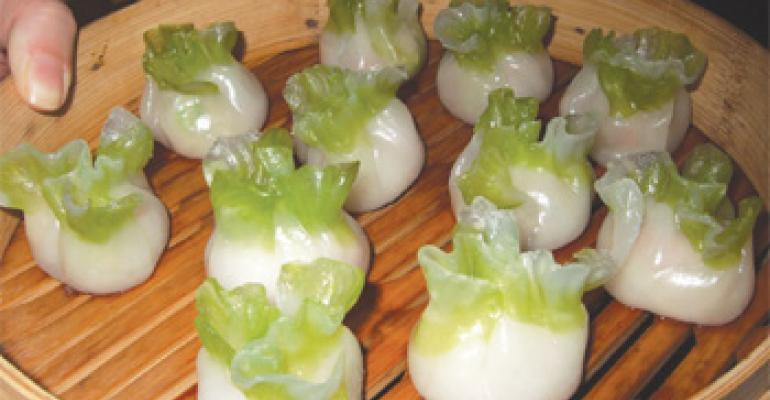Five years ago chef Charles Phan sold about six orders of whole fish a night, and many were sent back at his Slanted Door restaurant in San Francisco. Now he sells about 23 whole fish an evening, and not one has been sent back in the past couple of years, he said.
Diners are stepping outside their comfort zones and opening their minds and mouths to dishes from far-flung global cuisines that now are ripe for exploitation in restaurants. That was the message from Phan and other experts at the 10th annual Worlds of Flavor International Conference and Festival.
The three-day event, whose theme was “The Rise of Asia,” was presented by The Culinary Institute of America at Greystone in Napa Valley, Calif. More than 75 experts gathered for demonstrations and tastings of regional cuisines from China, India, Japan, Korea, Malaysia, Pakistan, Singapore and Vietnam.
“In middle America there is definitely a yearning for something different,” Phan said.
Slanted Door’s wood-oven-baked whole fish comes with spicy ginger sauce on the side and currently is the second-highest-priced dish on the dinner menu at $28.50.
“People are very curious about emerging global cuisines from around the world, not only the general [styles], but also regional cuisines from that country of origin,” said the Worlds of Flavor event co-chair, Mai Pham. Pham is chef-owner of Lemon Grass Restaurant and Lemon Grass Asian Grill and Noodle Bar, both in Sacramento, Calif.
Pham urged attendees not to be afraid to introduce dishes that are not mainstream. She pointed out the success of pho soup, a hearty Vietnamese noodle soup served with whole leaf herbs, that she brought in four years ago to the University of Massachusetts at Amherst foodservice facilities as a consultant. “They had a very small Asian population there, yet [the pho] hit the campus by storm,” she said.
In the United States many people now eat out-of-the-ordinary ethnic dishes, said Elizabeth Andoh, a Japanese cuisine specialist based in Tokyo. Establishments offering such cooking have “opened up now from fine dining to casual dining,” she added.
This increased acceptance of lesser-known, global dining is due mostly to increases in international travel, said Worlds of Flavor co-chair Fuchsia Dunlop, a Chinese food authority from London.
“This is just the tip of the iceberg,” Dunlop said. “We should not underestimate palates.”
Floyd Cardoz, executive chef of Tabla in New York, said he’s noticed a shift in consumers’ tastes since his restaurant was established close to a decade ago. Lately, he said, he received increased requests for more authentic regional dishes from his native India, and he’s following those guests’ wishes.
“I have to take it further now because more people want it,” Cardoz said.
United States-based cooking show host and chef Martin Yan reminded the Worlds of Flavor audience that authentic regional Chinese food has become more common. Currently, he added, Americans enjoy balanced flavors and “don’t hesitate to even eat chicken feet.”
Poultry parts aside, some chains are preparing to dive into regional cuisines from around the globe. Chris Gatto, vice president of food and beverage at Boston-based Uno Chicago Grill, which has more than 200 locations, said after attending the Worlds of Flavor event that he was impressed with “how healthy and nutritious Asian cuisine can be due to the large use of herbs and spices and the smaller amounts of meats and proteins used in their dishes.”
“The focus for us at Uno Chicago Grill is and always will be that the food has got to taste great,” he added, “and will be as nutritious as possible without sacrificing flavor. Our customers would certainly be interested if we introduced and marketed items as authentic regional cuisine. Our menu is not specific to certain regions. So as long as [a dish] sounded appetizing and fit within our menu style, they would be open to trying it.”
Golden Corral’s senior manager of recipe development, Debra Olson, who is based at company headquarters in Raleigh, N.C., agreed. At her all-you-can-eat buffet-style concept, “the advantage is our guests can try dishes” that may be unfamiliar, she said.
Currently about 20 of the nearly 500 Golden Corrals offer a “Pagoda station” with stir-fried dishes cooked using a technique she saw Worlds of Flavor chefs from China demonstrate. Before the conference she didn’t know the technique was authentic, she says.
The Chinese chefs often used precooked proteins that were deep-fat-fried or stir-fried to add to a wok with other ingredients, which were also often precooked.
By using this cooking style, “you get a layering of flavors,” Olson said.
“It’s all about flavor,” said attendee Chad Thompson, senior director of menu development/R&D at Einstein Noah Restaurant Group, based in Lakewood, Colo., with approximately 600 locations.
When it comes to respecting those flavors, “we don’t want to dumb it down,” added Shawn Kearns, Einstein Noah’s director of menu development/R&D.
However, based on findings from focus groups, Einstein’s diners do not really care if a dish is 100-percent authentic, Thompson said.
Authentic “is a meaningless word,” said David Chang of Momofuku Noodle Bar in New York. In the United States, “you’re not going to get the same ingredients,” as in Japan, such as dried bonito, he said.
“You just have to make do and be clever,” Chang said. “One of the flavor profiles in Japan that we’re trying to mimic is smoky. I can get amazing bacon here.”
So to achieve a similar taste, Chang flavors a broth with bacon and incorporates it in grits with poached egg.
“Instead of saying we serve authentic,” Chang said, “we try to serve really delicious food.”




